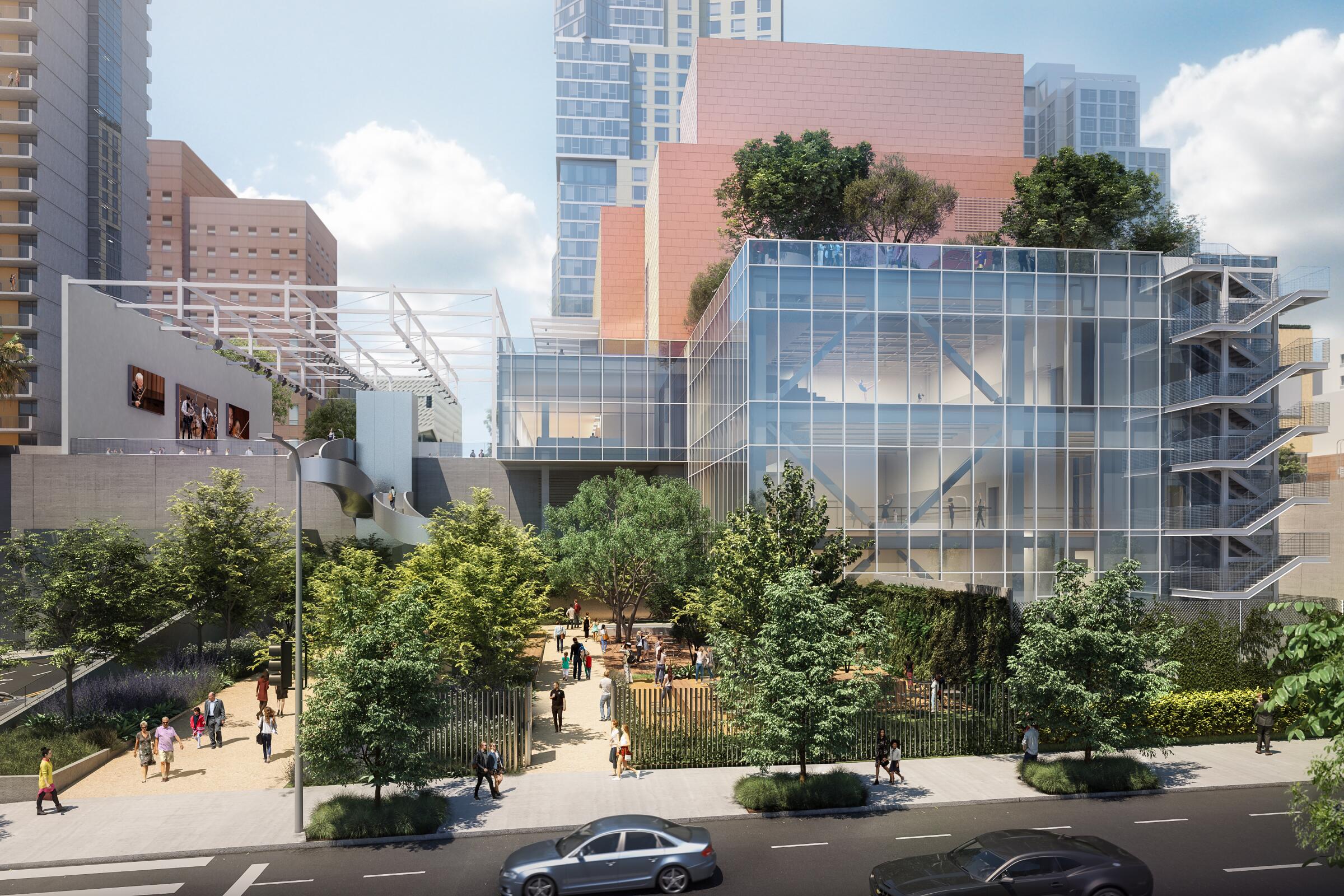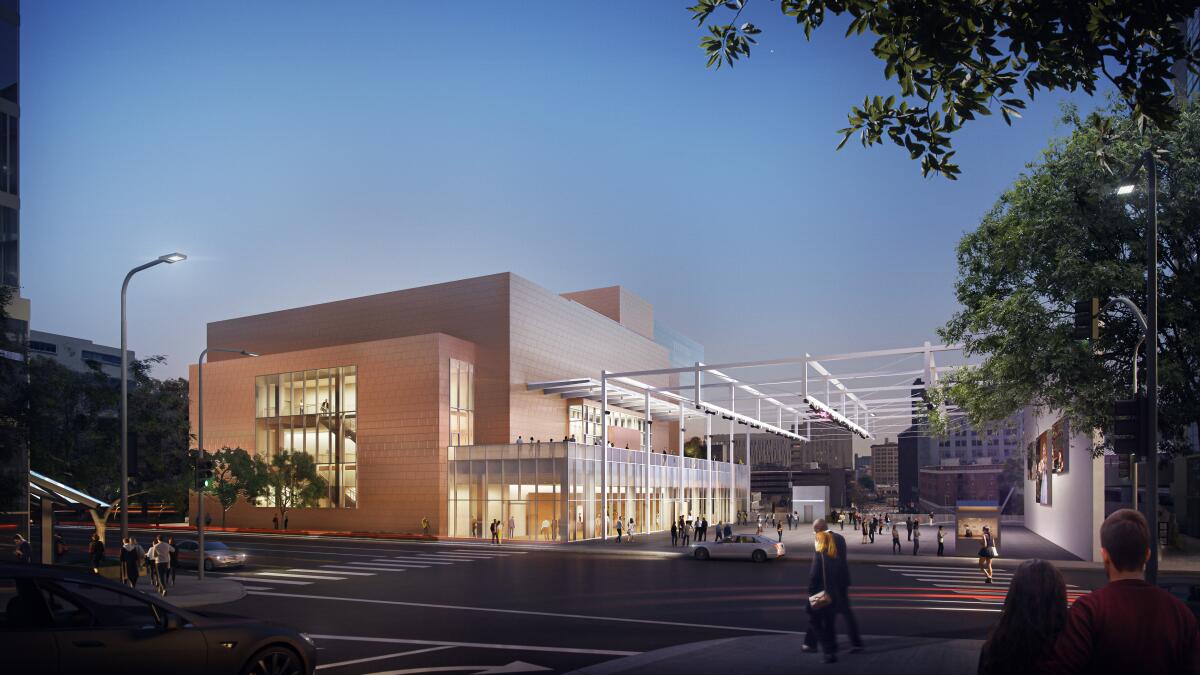The biggest entertainment stories
Get our big stories about Hollywood, film, television, music, arts, culture and more right in your inbox as soon as they publish.
You may occasionally receive promotional content from the Los Angeles Times.

In 2016, Colburn — the community music school, conservatory, academy and dance school — bought a cheerless outdoor parking lot on the corner of 2nd and Olive streets downtown for $33 million. It was on a steep, pedestrian unfriendly hill that led to the Colburn’s Grand Avenue campus, the Museum of Contemporary Art, Walt Disney Concert Hall and the Broad. There was little foot traffic, and the area was deserted at night.
But the school had always wanted the kind of midsize concert hall that it and the city lacked. Now, after many ups and downs, Colburn is announcing plans to build a concert hall, performance plaza and dance studios designed by Frank Gehry on the site. It will not only serve an institution that looks after the music and dance education of students from infants to seniors but will also reach out to and offer a civic gathering place for a broad public.
The hall will stand behind the Grand — the spectacular, multipurpose complex across the street from Disney Hall that was also designed by Gehry and is set to open in May. Its potential is to become the linchpin for finally turning Grand Avenue into a thriving arts district of international importance.
The buildings have radically changed in appearance from the glittery renderings that Gehry and Partners released to The Times in 2020 in hopes of stimulating philanthropic support. Fundraising stalled during that first summer of the COVID-19 pandemic, when the future looked too economically uncertain.
But a sustaining donation from Carol Colburn Grigor, daughter of the school’s founder, Richard D. Colburn, saved the concert hall. Further contributions from Terri and Jerry Kohl, for whom the hall will be named, will help fund the hall’s endowment, making possible its widespread use as a community venue and helping keep ticket prices low. Eva and Marc Stern are the other major donors. The individual sums are not being announced, but the total budget for the full project and its initial endowment is estimated at $350 million, of which $270 million has been raised.
Even so, the budget for the concert hall, which was to have been around $300 million, had to be halved. Instead of a concert hall/opera house and cabaret as originally intended, there will be a single 1,000-seat concert hall in the round. In an effort to cut costs, Gehry has replaced the dazzling glass façade with a less conspicuous exterior, which will be either stainless steel or, if affordable, a pinkish tint of titanium.

For Gehry, however, the original design is ancient history. Standing next to the model of the hall in his studio, the 93-year-old architect enthuses about how his new ideas for the hall are not compromises but improvements. He has proudly embraced cost-cutting as a symbol for making a wide variety of music, for which he has an abiding passion.
He wants to get down to the basics of what a concert hall should be in serving the needs of music, society and the city. This, he notes, has become one of the main missions of his late career, as epitomized in the Judith and Thomas L. Beckmen YOLA Center in Inglewood and the transformative cultural center he has designed for the Los Angeles River in South Gate.
The interior of the Colburn hall will be plain plywood and, if anything, all the more stunning because of it. An elegant suspended balcony with two rows of seats will become the hall’s crown. Arresting white Gehry-esque clouds will create a dramatic ceiling. Above them will be catwalks intended for events and performances, making the ceiling a uniquely active part of the hall.
Yasuhisa Toyota will be the acoustician, as he has been for all Gehry’s concert halls, beginning with Disney. The slight oval shape, with the audience surrounding the stage, represents Gehry’s and Toyota’s latest thinking about interior concert spaces. Both architect and acoustician are hooked on the concept of modular venues in the round, with that wisp of a suspended balcony they pioneered five years ago with the Pierre Boulez Saal in Berlin.
That small, also modest hall turned out to be one of the most magical spaces anywhere to hear music of all sorts. At every seat, you feel as though you are in direct contact with the performer. The sound has an immediacy and presence like no other space I’ve encountered. With imaginative concerts nearly every night in Berlin, the Boulez Saal has brought new vitality to the cultural life of a cultural capital already so vital that it didn’t even know it needed the venue.
Colburn’s president and chief executive, Sel Kardan, told me that the Boulez Saal is very much a model for what the new hall could become, but on a grander scale. Not only will Colburn’s hall be a third larger than the Boulez Saal and with an airy high ceiling giving the acoustic volume to handle a full orchestra but it will also be equipped for theatrical performances as well as purely musical ones.
Gehry designed a full-size orchestra pit that can hold up to 70 players when used, making this the perfect size for Baroque opera, Mozart, 20th-century chamber opera and the experimental work that excites today’s young composers. Dance in the round becomes an intriguing possibility. Los Angeles Opera, the Los Angeles Philharmonic and the Los Angeles Chamber Orchestra are eager occupants.
But Kardan is just as eager to make the hall available at low cost to community ensembles that work in a wide range of genres and cultures, as well, of course, making the space a place where students can imagine. “It’s a music school,” Gehry exclaims. “You don’t need fancy materials.” The students need to feel free.

Like the Boulez Saal, the hall will be active nearly every night, bringing much new life to the area, particularly in the summer. That crowd energy is also key to Gehry’s aim, which is to connect the hall and its adjoining dance building culturally and physically with the street. A new Metro station is under construction a block east of the buildings. The 2nd Street hill will be leveled, creating a landscaped pedestrian pathway. The halls will be reached by elevator or stairs.
What pedestrians will first encounter will be the three-story dance building that Gehry has designed in all glass, with a large studio on the ground floor visible to passersby, bringing art to the street. The concert hall will open to a proposed large plaza (for which City Hall still needs to give final approval), with a panoramic video wall and suspended surround sound system capable of broadcasting performances, without charge, inside the hall for up to 800 people outside. Balconies on the hall provide spaces for musicians to further break the barriers for indoor and outdoor performance.
Gehry insists that I take a trip downtown with him to get a sense of the scale. Standing in the parking lot where the hall will be built, he looks up approvingly at the Grand (which he finds has turned out better than he expected) and gestures around the corner of Grand and 2nd. The difference between a livable arts district and the corporate towers to the south or the government buildings to the northwest is striking.
He may be in his 90s and have already revolutionized Grand Avenue, but Gehry acts as though he’s just begun. As we walk to Disney, Gehry demonstrates how the new Colburn complex will become the connecting hub to Grand Avenue. Inside his already iconic concert hall, he describes his ideas for turning BP Hall, where pre-concert talks are given, into a small chamber music hall, with a suspended balcony. He wants to make the little-used amphitheater in the garden into an enclosed jazz club, but he wonders where to put a bar. Gehry spends a moment walking around and finds a space. He has ideas for the lobby and the dark café at Disney, which he didn’t design but wanted to.
Grand Park is next. The city buildings have to go, he says. They have asbestos and are in bad shape. His vision? Tear them down, build a tower on what will be the last empty lot on 1st Street for the city courts and administration so you can widen the park and put in affordable housing around it.
Years ago, he proposed lowering the Music Center to street level, but no one listened. Do it now, he says, and everything connects. What you get is a full-fledged arts district, with museums and theaters of all sizes (having altogether some 12,000 seats), housing and, thanks to the Grand, stores, restaurants, a hotel and three nearby Metro stops. He is advocating for the Grand to include a market. Between the 1st Street Metro stop and the Colburn, he suggests a strip with donut shops, coffee bars and falafel stands that could be a hangout for music and dance students. He wants life everywhere.
In the end, Gehry sees the Colburn project as impetus for a utopian vision of DTLA. The fact is, arts have no right to thrive at the expense of society, and I ask Gehry whether L.A. can be the kind of city that can invest in a uniquely inclusive arts district — not instead of but along with investing whatever it takes to overcome homelessness and other critical issues. He doesn’t have an answer, just a vision. The challenge and fundamental promise of the new Colburn complex are for us to make it the stepping stone in creating that vision. Think of what that might look like in summer 2028, when the world turns its attention on the L.A. Olympics.
A few years ago, $33 million seemed a lot of money for a cheerless parking lot. “It wasn’t cheap,” Kardan says. In the best of all possible worlds, that ranks as a historic bargain.
The biggest entertainment stories
Get our big stories about Hollywood, film, television, music, arts, culture and more right in your inbox as soon as they publish.
You may occasionally receive promotional content from the Los Angeles Times.